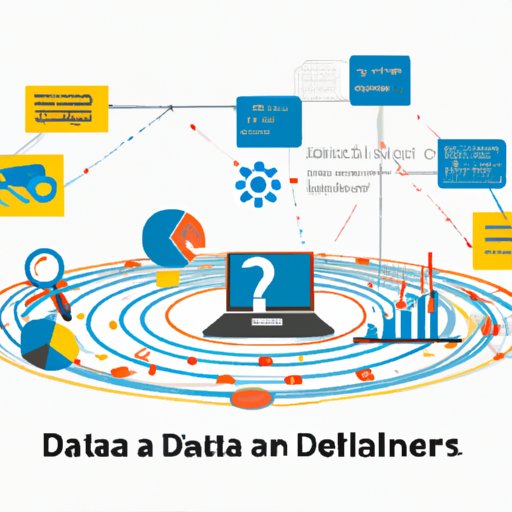Introduction
Data science is a rapidly growing field that combines statistical analysis, computer programming, and business knowledge to uncover insights from large sets of data. As companies are increasingly turning to data-driven decision making, data science projects have become essential for businesses in understanding customer behavior, predicting future trends, and optimizing operations. But how do you actually do a data science project? This article will provide an overview of the steps involved in doing a data science project.
What is a Data Science Project?
A data science project is a systematic approach to solving a problem using data. It typically involves gathering and organizing data, analyzing data, building models, and deploying and maintaining the model. Data science projects can be used to solve a wide range of problems, such as predicting customer churn, optimizing pricing strategies, and forecasting sales. By leveraging data, data science projects can help organizations make more informed decisions and drive better business outcomes.
Why Should You Do a Data Science Project?
Data science projects can provide valuable insights into a variety of business problems. By uncovering insights from data, organizations can make more informed decisions, optimize processes, and increase efficiency. In addition, data science projects can also help organizations identify new opportunities and stay ahead of the competition. Therefore, it is important for organizations to understand how to do a data science project.
Outlining the Steps of a Data Science Project
Doing a data science project requires careful planning and execution. The following sections outline the steps involved in doing a data science project.

Step One: Create a Roadmap
The first step in doing a data science project is to create a roadmap. A roadmap is a plan of action that outlines the goals and objectives of the project, sets milestones, and establishes a timeline. It is important to create a roadmap as it helps to ensure that the project is completed on time and within budget.
Identify Your Goals. The first step in creating a roadmap is to identify your goals. What problem are you trying to solve with your data science project? Are you looking to uncover customer insights, predict future trends, or optimize operations? Once you have identified your goals, you can create a plan of action to achieve them.
Set Milestones. After identifying your goals, the next step is to set milestones. Milestones are important as they help you track progress and measure success. They should include both short-term and long-term goals, and should be realistic and achievable.
Establish a Timeline. The final step in creating a roadmap is to establish a timeline. This should include the start date, end date, and any key dates in between. It is important to establish a timeline as it helps to keep the project on track and ensures that deadlines are met.
Step Two: Explore Data Sources
Once you have created a roadmap, the next step is to explore data sources. Data sources can include internal databases, external datasets, and public information. Exploring data sources helps to ensure that you have the necessary data to complete the project.
Gather and Organize Your Data. The first step in exploring data sources is to gather and organize your data. This includes collecting data from internal and external sources, formatting the data, and ensuring that it is organized in a logical way. It is important to ensure that the data is accurate and up-to-date.
Choose an Appropriate Data Storage System. The next step is to choose an appropriate data storage system. Data storage systems can include relational databases, NoSQL databases, and cloud storage solutions. When choosing a data storage system, it is important to consider the size and complexity of the data, as well as the security needs of the organization.
Evaluate Data Quality. The final step in exploring data sources is to evaluate data quality. Data quality is an important factor as it determines the accuracy of the results. It is important to ensure that the data is complete, accurate, and up-to-date.
Step Three: Analyze Data
Once the data has been gathered and organized, the next step is to analyze the data. Analyzing data helps to uncover insights, identify patterns, and gain a better understanding of the problem. There are several steps involved in analyzing data.
Clean, Transform, and Prepare Data. The first step in analyzing data is to clean, transform, and prepare the data. This includes removing irrelevant data, correcting errors, transforming variables, and preparing the data for further analysis. It is important to ensure that the data is in a usable format before proceeding with the analysis.
Use Descriptive Statistics to Summarize Data. The next step is to use descriptive statistics to summarize the data. Descriptive statistics can include measures of central tendency, dispersion, and correlation. These measures help to provide a general view of the data and can help to identify patterns and relationships.
Utilize Visualizations to Understand Patterns in Data. The final step in analyzing data is to utilize visualizations to understand patterns in the data. Visualizations can help to identify correlations, outliers, and trends. They can also help to communicate the results of the analysis in an easily understandable manner.
Building Models for a Data Science Project
Once the data has been analyzed, the next step is to build models. Models are mathematical equations or algorithms that are used to make predictions or decisions based on the data. There are several steps involved in building models.
Step Four: Develop Models
The first step in developing models is to select an algorithm or model. There are many different types of algorithms and models, such as decision trees, neural networks, and support vector machines. It is important to select an appropriate algorithm or model that best fits the problem.
Train the Model. The next step is to train the model. This involves feeding the model with the training data and adjusting the parameters of the model to improve its performance. It is important to ensure that the model is trained properly so that it can accurately predict outcomes.
Evaluate the Model. The third step is to evaluate the model. This involves using metrics such as accuracy, precision, recall, and F1 score to measure the performance of the model. It is important to evaluate the model to ensure that it is performing as expected.
Refine the Model. The final step in developing the model is to refine the model. This involves fine-tuning the parameters of the model and making improvements to increase its performance. It is important to continually refine the model in order to ensure that it is performing optimally.

Step Five: Deploy and Maintain the Model
Once the model has been developed, the next step is to deploy and maintain the model. This involves deploying the model to production and monitoring its performance. It is important to monitor the model to ensure that it is performing as expected.
Deploy the Model. The first step in deploying the model is to deploy it to production. This typically involves setting up an environment where the model can be accessed by users. It is important to ensure that the model is deployed correctly so that it can be used by users.
Monitor Model Performance. The next step is to monitor the model’s performance. This involves tracking metrics such as accuracy, precision, and recall to ensure that the model is performing as expected. It is important to regularly monitor the model’s performance in order to ensure that it is performing optimally.
Make Improvements. The final step in deploying and maintaining the model is to make improvements. This involves evaluating the model’s performance and making changes to improve its accuracy and performance. It is important to continually make improvements to the model in order to ensure that it is performing optimally.
Conclusion
Doing a data science project requires careful planning and execution. This article outlined the steps involved in doing a data science project, including creating a roadmap, exploring data sources, analyzing data, developing models, and deploying and maintaining the model. By following these steps, organizations can make more informed decisions, optimize processes, and increase efficiency.
Summary of Steps
To do a data science project, the following steps are recommended: create a roadmap, explore data sources, analyze data, develop models, and deploy and maintain the model. By following these steps, organizations can make more informed decisions, optimize processes, and increase efficiency.

Benefits of Data Science Projects
Data science projects can provide valuable insights into a variety of business problems. By uncovering insights from data, organizations can make more informed decisions, optimize processes, and increase efficiency. In addition, data science projects can also help organizations identify new opportunities and stay ahead of the competition. Therefore, it is important for organizations to understand how to do a data science project.
(Note: Is this article not meeting your expectations? Do you have knowledge or insights to share? Unlock new opportunities and expand your reach by joining our authors team. Click Registration to join us and share your expertise with our readers.)
